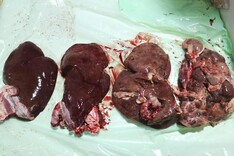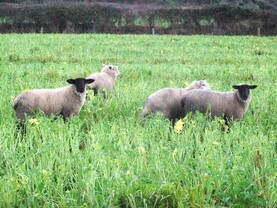Liver fluke threat
Veterinary laboratories and some factories are starting to report isolated incidences of active liver fluke infestations in the livers of lambs and ewes. The highest number of reports, as expected, is along the western half of the country and parts of the midlands and north. As such, it is important to be aware of the risks and follow up on the health status of livers in animals presented for slaughter and submit any cases of unexplained mortality for post-mortem analysis.
Acute fluke traditionally pose the greatest risk in the period from August through to October. This stage of the disease is best characterised by rapid ingestion of high numbers of immature fluke which burrow through the liver. This can lead to weakness of the animal, anaemia and sudden death. There is often no characteristic symptoms, with well-fleshed animals with a high acute burden often collapsing when put under stress and dying due to haemorrhaging of their liver.
As you progress through November, this generally transitions to subacute fluke disease being the greatest threat (still some early immature fluke present but growing numbers of immature and mature fluke). Losses due to anaemia and sudden death are still possible but as you get closer to Christmas and the new year the risk switches to chronic liver fluke.
Product selection is therefore vital. Products selected for treating sheep at present should target at least immature liver fluke, steering clear from products which only target mature fluke. Reports also point to continued worm burdens in lambs, with farmers often selecting combination worm and fluke products for ease of use.
Caution should be practised here, as many of these products only target mature fluke and are therefore ineffective at present in targeting the stage of liver fluke doing the greatest amount of damage. There is no need to treat healthy ewes for worms and likewise there is no need to treat animals for rumen fluke unless there is a known level of disease that warrants treatment.
Clean livestock policy
Issues are emerging at factories, with most in the last week relating to the handling and transport of lambs and fleece contamination. Factories report the greatest challenge is with lambs presented with wet contaminated fleeces as this reduces options for remedial work pre-slaughter. Where lambs are grazing low dry matter swards and are loose in the dung it is worth fasting for a period, housing in advance of transport or temporarily switching lambs away from lush low dry matter swards. Drafting lambs when dry and ensuring the floor of trailers is bedded with an appropriate material to soak urine and faeces will also help. Sticking to the appropriate stocking rate and using dividers where appropriate to segregate lambs is also important.
Scanning early lambing ewes
It is worth scanning early lambing ewes both as a management tool to accurately plan late pregnancy feeding programmes but also to allow an opportunity to join empty ewes for mid-season lambing where appropriate. The ideal time frame to scan is 80 to 90 days post ram turnout. Early lambing ewes are typically in good body condition at this time of year and delaying scanning in such ewes beyond day 100 of gestation can reduce the accuracy in determining litter size.






 This is a subscriber-only article
This is a subscriber-only article










SHARING OPTIONS: